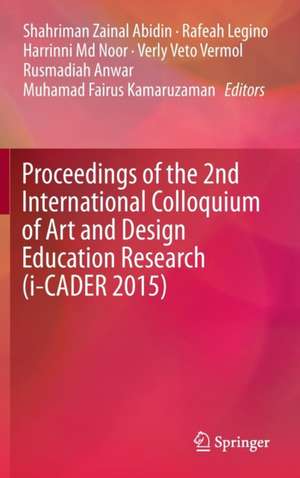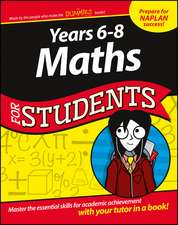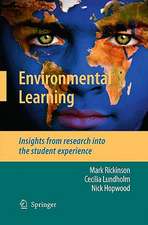Proceedings of the 2nd International Colloquium of Art and Design Education Research (i-CADER 2015)
Editat de Shahriman Zainal Abidin, Rafeah Legino, Harrinni Md Noor, Verly Veto Vermol, Rusmadiah Anwar, Muhamad Fairus Kamaruzamanen Limba Engleză Hardback – 22 mar 2016
This book features 66 papers from the 2nd International Colloquium of Art and Design Education Research, i-CADER 2015. It illustrates the wide range of opinions and interpretations, mediums and technologies, policies and methodologies in this field.
The papers, which have been reviewed by 380 experts from around the world, underline the latest trans-disciplinary research in art and design education. Coverage examines organization and sustainable issues, including: creative processes, knowledge and experience, design industrial applications, sustainable design, visual communication and new media, art education research, cultural studies, teaching and learning implications on art, traditional knowledge, and new technologies for industries.
In addition, the volume also explores innovative research trends in cross-disciplinary findings, combining methodology and theory. Overall, readers are provided with an insightful analysis of the latest research and advances in art and design education.
| Toate formatele și edițiile | Preț | Express |
|---|---|---|
| Paperback (1) | 1234.46 lei 6-8 săpt. | |
| Springer Nature Singapore – 19 iun 2018 | 1234.46 lei 6-8 săpt. | |
| Hardback (1) | 1240.93 lei 6-8 săpt. | |
| Springer Nature Singapore – 22 mar 2016 | 1240.93 lei 6-8 săpt. |
Preț: 1240.93 lei
Preț vechi: 1513.33 lei
-18% Nou
Puncte Express: 1861
Preț estimativ în valută:
237.48€ • 247.02$ • 196.05£
237.48€ • 247.02$ • 196.05£
Carte tipărită la comandă
Livrare economică 14-28 aprilie
Preluare comenzi: 021 569.72.76
Specificații
ISBN-13: 9789811002359
ISBN-10: 9811002355
Pagini: 659
Ilustrații: X, 660 p. 357 illus.
Dimensiuni: 155 x 235 x 37 mm
Greutate: 1.11 kg
Ediția:1st ed. 2016
Editura: Springer Nature Singapore
Colecția Springer
Locul publicării:Singapore, Singapore
ISBN-10: 9811002355
Pagini: 659
Ilustrații: X, 660 p. 357 illus.
Dimensiuni: 155 x 235 x 37 mm
Greutate: 1.11 kg
Ediția:1st ed. 2016
Editura: Springer Nature Singapore
Colecția Springer
Locul publicării:Singapore, Singapore
Public țintă
ResearchCuprins
1: Creative Plan and Decision Choice of Semantic Differential Approach for Chair Design Aesthetic.- 2: The Conceptual Framework of Hydroxyapatite Fibre Structure by Slip Casting Techniques.- 3: Ceramic Art: An Introductory of MYP Curriculum Design for International Baccalaureate Visual Art.- 4: Recognisability of Pictographs on Electrical Consumer Products.- 5: A Practical Design of Kiln Building: Small Scale Portable Kiln.- 6: Luminescent Properties of SrAl2O4 activated Eu2+, Dy3+ for Transparent Glaze Ceramic.- 7: The Theoretical Framework of Replaceable Ventilation Blocks Using Modified Stoneware body.- 8: Traditional Songket to Contemporary Designs Towards Commercial Products.- 9: Ceramic Extruder Technique Incorporate with QR Code Bar: A Proposed Ventilation Design.- 10: Relative Theory of Tactile Iconography Array Configuration for The Blind Group.- 11: Variations of Malaysian Batik Sarongs Design Motifs.- 12: Innovation Method of Smoke Firing for Labu Sayong Blackening Technique: Kiln Design.- 13: Genetic Algorithm as A Generative Tool to Search for Malaysia Product Design DNA.- 14: The Impact of Agricultural and Industrial Based Waste in Stoneware Body: The Comparative Study.- 15: The Strength of Modified Stoneware Body for Extrusion of Ceramic Vents Design.- 16: Applied Research of Semangat Lita’rafu Entrepreneurship Model: An Empirical Case Study of Rural Resident in Malaysia.- 17: Ablution Tap Design: A Solution for Water Consumption.- 18: Application of Low Temperature Transparent Glaze in Sustaining Luminous Grains for Ceramic Artwork Surface Treatment.- 19: The Design Study of Walet Scaffolding Nest.- 20: Innovation in Form Generation: Anthropomorphism for Contextual Collaboration in Car Styling.- 21: Moderating Effects of Stylized and Realistic Stimuli on The Relationship Between The Uncanny Valley Theory and Digital Characters’ Features.- 22: A Study on Photographic Images of the Perak State Tourism Campaign Billboards.- 23: How Anthropomorphic Traits Facilitate Interaction and Build Relationship: Case Study of Four Malaysian Brands.- 24: An Approach Using Photographs as Part of the Therapeutic Process for the Mentally Ill : Case Study on Mental Illness Patients, Malaysia.- 25: Managing Stress by using Digital Visual Schedule among Adolescence.- 26: Halal’s Logo Design Application on Grocery Products in Malaysia.- 27: The Malay Cultural Symbol in The Malaysian Modern Sculpture.- 28: Art Appreciation: An Introduction on the Artistic Creativity of Contemporary Artists of Sabah.- 29: The Characteristic of Multi-Function Malaysian Art Galleries.- 30: The Investigating of Meaningful Ornaments on Terengganu Boats.- 31: Malaysian Product Design Identity: Issues, Transformation and Challenges.- 32: Rhetorical Comparison on the Promotional Strategies used in Performing Art and Visual Art Research Articles.- 33: Investigation of Materials on Artificial Reef By Using Sabak Bernam Local Clay.- 34: Visual Thinking Courseware: Enhancing Critical Thinking Skills through Art Criticism.- 35: A Preliminary Study of Robotic Education in Malaysia.- 36: The New Developments and Education of Traditional Music: Jiang-Nan-Si-Zhu in Taiwan.- 37: Designing Mobile Augmented Reality (MAR) for Learning Chemical Bond.- 38: Review of Learning Activities in Facebook to Inculcate Meaningful Learning.- 39: Needs Analysis in Developing Culturally Responsive Arts Education Pedagogy Module.- 40: Hybrid Element in Installation Visual Artwork.- 41: Monoprint Technique, Medium and Expression.- 42: Women Artist in Malaysian Visual Art History and Development.- 43: The Structure of Malay Woodcarving Motifs in Craft Education Module.- 44: Utilisation of Research Workbook as an Assessment Tool in Promoting Cultural Awareness and Understanding.- 45: The Appropriateness of Animated TV Advertisement in Creating Awareness towards Truancy among Secondary School Student: A Case Study in Klang, Malaysia.- 46: Analysis of Ergo-Aesthetics Assessment: A Case Study on Public Park's Benches.- 47: The Cost-Related Issues in Malaysian Construction Contracts.- 48: Ablution Design: The Concepts and Design Criteria.- 49: The Perak Malay Landscape Furniture Design: An Overview.- 50: Designing ‘Embouchure Clay’ Parameter Formulation: Sabak Earth Ceramic Craft.- 51: The Significance of Prayer Room Design Standards at Shopping Complex.- 52: Development of the Contemporary Painting in Malaysia.- 53: Adapting Muwajjah Vector Analysis: Prominent Feature in Islamic Art.- 54: Printmaking Terminology: Correlation on Definition Study between Matrix in Printmaking and Ready-Made Material Mould in Industries.- 55: Printmaking: Moulding as an Alternative Artwork.- 56: Comparison of Chinese Calligraphy and Ink Painting Brushes with Western Water-media Painting Brushes.- 57: Thematic Analysis as a Basis in Giving Meanings on Myths of Nunuk Ragang and Huminodun Folktales of Kadazandusun Tribe in Sabah.- 58: Method Design of Keris Pandai Saras.- 59: Islamic Features Adaptation in Songket Design.- 60: Kufi Lari: The Hybrid of Khat Kufi to Uphold the Malays' Identity in Digital Art Application.- 61: Representing Women: The Portrayal of Coloured Women in Malaysian Magazine WANITA.- 62: The Exploriation of Vegetables Dyes into Fiber Artworks.- 63: The Uniqueness of the Malay Traditional Embroidery: Kelingkan.- 64: The Transformation of Traditional Telepuk Motifs into Contemporary Artwork.- 65: The Role of Designomics in Jewellery Design.- 66: Islamic Geometric Pattern within the Molecular Structure.
Notă biografică
Shahriman Zainal Abidin is an Industrial Design graduate and is currently a teaching staff in Faculty of Art and Design, Universiti Teknologi MARA (UiTM). His teaching interests and experience are in the areas of design methodology, industrial design research and interaction design and automotive design. He received his PhD from the Norwegian University of Science and Technology in the field of Formgiving. His expertise resonates around the field of Formgiving research in automotive. Currently he is seconded to the Department of Research and Development in Proton Holdings Bhd., a Malaysia Automotive Company. He is in charge of creating the new Proton DNA design of the national car.
Verly Veto Vermol holds an MA in Design Technology and is currently pursuing his Phd, and teaching under the Department of Industrial Ceramic Design, Faculty of Art & Design, Universiti Teknologi MARA (UiTM), Shah Alam, Malaysia. His professional working experience with Guocera Tiles Industry as New Product Designer under the NPD and supporting R&D department under Ceramic Research Center brough about the opportunity to be involved in the International Tiles Exhibition (Cersaie)in Bologna Italy. He gained his professional training at Technoitalia, Indonesia, and in laser cylinder engraving in Gunung Puteri, Bogor Indonesia, and ROTO silicon drum engraving in Malaysia. He is also passionate about Barrier Free Environment and Sustainable Infrastructure Design for the disabled community and groups with special needs.
Rusmadiah Anwar is a lecturer of Faculty of Art & Design, Universiti Teknologi MARA (UiTM). He became an Associate Member of Institute of Electrical and Electronics Engineers (IEEE) Malaysia and Collective Member (University) for the International Academy of Ceramics, Geneva (NGO official partner of UNESCO) since 2011. He is a research member of the Formgiving Design Research Group, UiTM and is currently an active researcher focusing on Practiced-Based Design and Laboratory Based Design Method in investigating design and human behaviour. He has published his research in many conferences locally and internationally and most of these publications are indexed. He is also currently engaged in professional ventures as a member in Technical Committee on Ceramic Materials & Sanitary Fittings for SIRIM Bhd and Technical Program Committee for several of IEEE conferences.
Muhamad Fairus Kamaruzaman is a research member in Formgiving Design Research Group, Universiti Teknologi MARA (UiTM). As a senior lecturer he is actively engaged in researching in the fields of Assistive Design Technology, Mobile Learning, Human Behaviour and the impact of the designed environment on quality of life. He is also a member of the Institute of Electrical and Electronics Engineers (IEEE), Malaysia Design Council and has been appointed as publication Chair and technical committee for various International conferences.
Textul de pe ultima copertă
This book features 66 papers from the 2nd International Colloquium of Art and Design Education Research, i-CADER 2015. It illustrates the wide range of opinions and interpretations, mediums and technologies, policies and methodologies in this field.
The papers, which have been reviewed by 380 experts from around the world, underline the latest trans-disciplinary research in art and design education. Coverage examines organization and sustainable issues, including: creative processes, knowledge and experience, design industrial applications, sustainable design, visual communication and new media, art education research, cultural studies, teaching and learning implications on art, traditional knowledge, and new technologies for industries.
In addition, the volume also explores innovative research trends in cross-disciplinary findings, combining methodology and theory. Overall, readers are provided with an insightful analysis of the latest research and advances in art and design education.
Caracteristici
Details the latest trans-disciplinary research in art and design education
Explores innovative research trends in cross-disciplinary findings, combining methodology and theory
Features 66 papers from the 2nd International Colloquium of Art and Design Education Research, i-CADER 2015
Includes supplementary material: sn.pub/extras
Explores innovative research trends in cross-disciplinary findings, combining methodology and theory
Features 66 papers from the 2nd International Colloquium of Art and Design Education Research, i-CADER 2015
Includes supplementary material: sn.pub/extras






